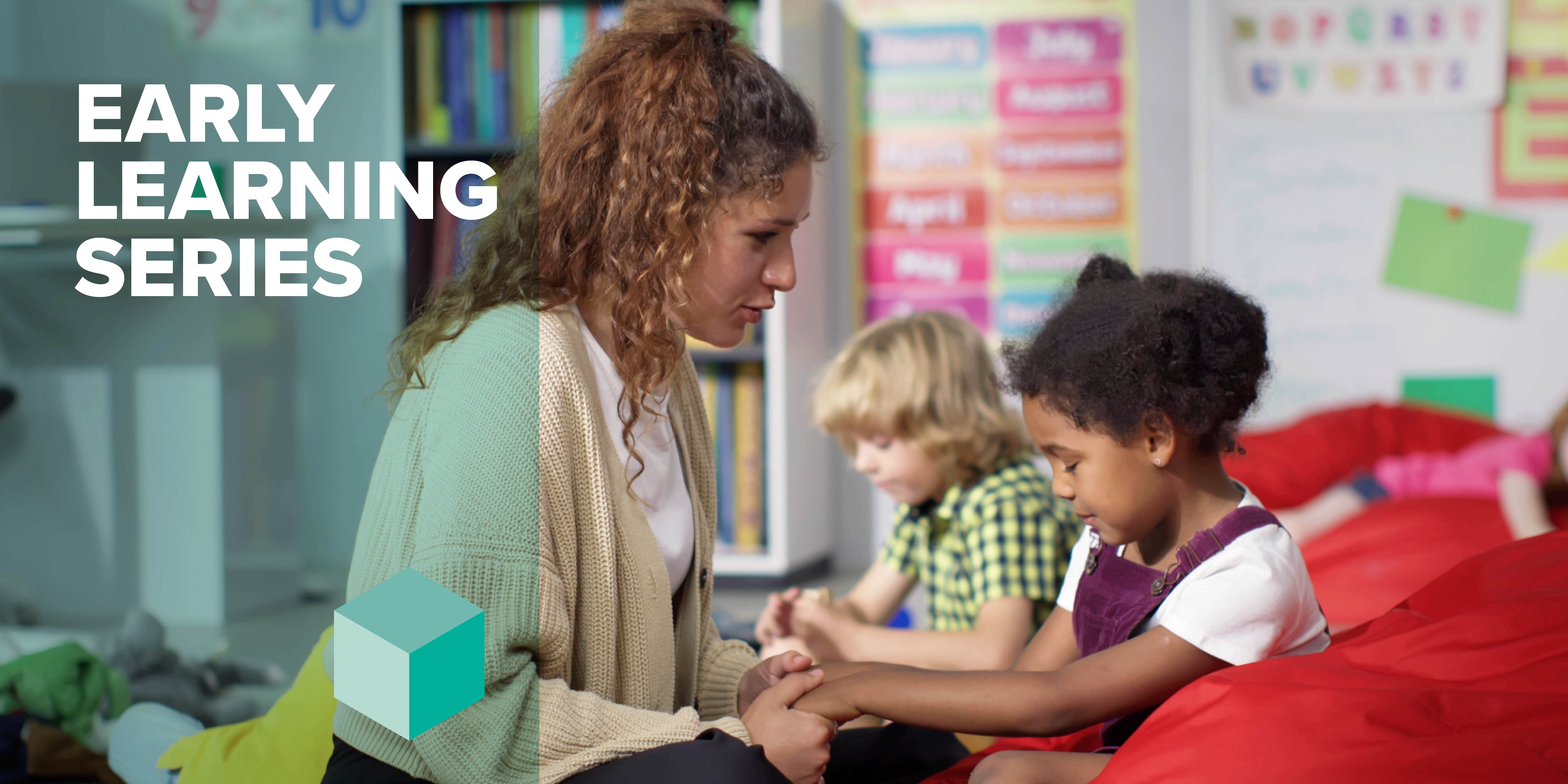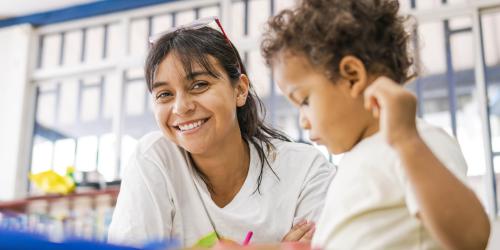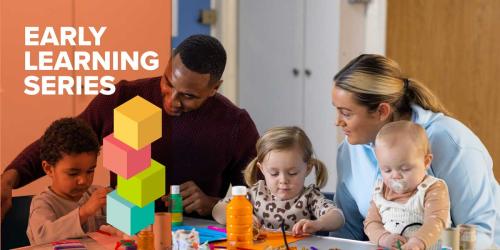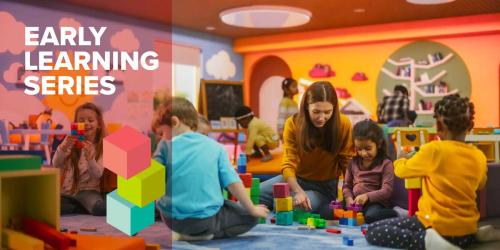How Preschool Programs Can Use SEL and Relationships to Foster Lifelong Learning

First impressions shape how we view and interact with other people, organizations, and institutions—including schools.
Many children get their first impressions of school in preschool. When their preschool experience is full of affirming and supportive relationships, children are more likely to view school positively and trust teachers and other adults who work in school settings.i
Two critical components of high-quality preschool programs are social and emotional learning (SEL) and ensuring each child experiences belonging, joy, and emotional supports that nurture learning.ii A focus on SEL, empathy, and emotionally supportive relationships also reduces the use of suspensions that remove children from classroom instruction—a critical goal after the COVID-19 pandemic, which caused a widespread increase in exclusionary discipline.iii
Below are some evidence-based SEL and relationship-building strategies that can help preschool programs deliver positive first impressions of school and foster lifelong learning among children.
Build Caring and Emotionally Supportive Relationships
When children experience encouragement and warmth from their teachers, they feel safe and ready to learn. Educators can build strong relationships by providing positive attention often, showing empathy that recognizes and validates children’s emotions, and supporting SEL throughout the school day. Together, these strategies create an environment where children learn to use communication, problem-solving, and self-regulation skills that prevent or reduce challenging behaviors.
Guiding children to develop positive relationships with their peers also encourages them to experience learning environments as safe and supportive. Educators set the example by having (and communicating) warmth and high expectations for every child, which helps children learn to see all their peers as key partners in learning. Educators can also model and teach positive interactions, for example, by using SEL strategies like collaborative problem solving, self-regulation, sharing, asking for help, and giving each child a leadership role. Educators can foster a sense of community by being intentional when grouping children for activities that foster play and interactions with peers of different abilities, cultural backgrounds, and identities (as opposed to grouping children by ability level).iv, v
Pay Attention to Nonverbal Behaviors
Educators’ nonverbal behaviors can influence how children evaluate their peers.vi When educators give a child positive nonverbal feedback, such as smiling or nodding their head, peers view that child as smarter or kinder than a child who receives negative nonverbal cues, like frowns or head shakes. Educators’ nonverbal behaviors may also communicate conscious or unconscious biases that may influence children’s stereotypic beliefs about a peer or group of peers.vii
To ensure that educators’ nonverbal behaviors contribute to positive peer relationships, educators can reflect on whether they use positive behaviors toward some students more than others. Patterns may show that we “leak” biases toward students who have different racial, cultural, or other backgrounds from us, which our nonverbal behaviors in turn communicate to other students in the class.viii Through reflecting and ensuring that each child receives a mix of positive feedback and areas of growth, educators can create an environment where each child sees their own and their peers’ potential for learning and success.
Engage Families in Meaningful Ways
Families are powerful, essential partners in the education of their children. By engaging families in authentic, two-way conversations, educators open the door to learn about children’s cultural backgrounds, families’ values and priorities for their children, and strategies to support children in the classroom. Regular, ongoing communication will engage families in setting goals for their children's learning as well as planning activities that embrace their culture, values, and priorities. This communication also fosters alignment between the home and early learning setting, which makes it easier for children to feel safe and comfortable.ix
Avoid Removing Children From Their Learning Setting
Removing children from preschool settings for disciplinary reasons has a significant and long-lasting negative effect. Expulsion rates are three times higher for children under age 5 compared to K–12 students, and young children who are removed from their learning settings are up to 10 times more likely to experience academic failure, have negative attitudes about school, drop out, and even face incarceration. In addition, research has shown that educators watch Black students, especially Black boys, more than students in other racial groups. Increased scrutiny leads to disproportionately high discipline rates for Black children, meaning inequitable access to high-quality learning environments starts before kindergarten.
Access to ongoing professional learning helps early childhood educators sharpen their practice and take advantage of new research and strategies for creating inclusive, equitable learning environments.
To reduce exclusionary discipline, Oregon and states across the U.S. are enacting legislation that limits suspensions and expulsions in pre-K through grade 5 to only incidents that threaten the safety of the child or others.x In addition, education leaders recognize the need for resources that will help preschool programs provide culturally responsive, high-quality early learning experiences that focus on prevention and SEL to promote school success.xi
These policy changes are important, but implementing them can be difficult for educators if they do not have other tools to address challenging behaviors. One way to provide additional tools is through professional learning. For example, Preschool For All, a public preschool initiative in Oregon, provides early childhood educators with training to ensure the program’s zero expulsion policy is implemented successfully. Access to ongoing professional learning helps early childhood educators sharpen their practice and take advantage of new research and strategies for creating inclusive, equitable learning environments. Important topics include establishing positive teacher-child relationships, recognizing and responding to children’s needs, integrating SEL into classroom practices, and using culturally affirming and sustaining practices.
More Resources for SEL and Relationships in Preschool Settings
Early childhood educators have an important role to play in student success. Providing them with resources and positive working environments is critical to building healthy, equitable learning environments. Here are additional resources to support preschool educators—and programs—in developing lifelong learners.
- Resources for Building Teacher-Student Relationships
- Building Inclusive Schools and Communities with the Community Conversation Toolkit
- Closing the Discipline Gap Where It Starts—in Preschool Programs
- Building Students’ Sense of Social Belonging as a Critical First Step
- Shifting the Current School Climate: Sense of Belonging and Social and Emotional Learning
- Now Is the Time to Focus on Educator Health and Well-Being
- From Family Engagement to Equitable Collaboration
- Understanding the Connection Between Family-School Engagement and Education System Transformation
1 Zöggeler-Burkhardt, L., Embacher, E., & Smidt, W. (2023). Social relationships, interactions and learning in early childhood—theoretical approaches, empirical findings and challenges. Early Childhood Development and Care, 193 (Issue 11‒12). https://www.tandfonline.com/doi/full/10.1080/03004430.2023.2260976
2 Martinsone, B., Supe, I., Stokenberga, I, Damberga, I., Cefai, C., Camilleri, L., Bartolo, P., O’Riordan, M. R., & Grazzani, I. (2022). Social emotional competence, learning outcomes, emotional and behavioral difficulties of preschool children: Parent and teacher evaluations. Frontiers in Psychology, 12. https://www.ncbi.nlm.nih.gov/pmc/articles/PMC8852736/
3 Egan, S. M., Pope, J., Moloney, M., Hoyne, C., & Beatty, C. (2021). Missing early education and care during the pandemic: The socio-emotional impact of the COVID-19 crisis on young children. Early Childhood Education Journal, 49(5), 925‒934.
4 Bovey, T., & Strain, P. (2003). Promoting positive peer social interactions. What Works Briefs. Center on the Social and Emotional Foundations for Early Learning http://csefel.vanderbilt.edu/briefs/wwb8.pdf
5 Manaster, H., & Jobe, M. (2012). Bringing boys and girls together: Supporting preschoolers’ positive peer relationships. Young Children, 67(5), 12–17. https://eric.ed.gov/?id=EJ997247
6 Brey, E. & Shutts, K. (2018). Children use nonverbal cues from an adult to evaluate peers. Journal of Cognition and Development, 18, 121‒136.
7 Brey, E., & Pauker, K. (2019). Teachers’ nonverbal behaviors influence children’s stereotypic beliefs. Journal of Experimental Psychology, 188. https://www.sciencedirect.com/science/article/abs/pii/S0022096519301468?via%3Dihub
8 Neitzel, J. (2018). Research to practice: Understanding the role of implicit bias in early childhood disciplinary practices. Journal of Early Childhood Teacher Education, 39(3), 232–242. https://eric.ed.gov/?id=EJ1185240
9 Sheridan, S. M., Knoche, L. L., Edwards, C. P., Bovaird, J. A., & Kupzyk, K. A. (2010). Parent engagement and school readiness: Effects of the Getting Ready intervention on preschool children's social–emotional competencies. Early Education and Development, 21(1), 125–156. http://eric.ed.gov/?id=EJ877206
10 Nishioka, V., Merrill, B., & Hanson, H. (2021). Changes in exclusionary and nonexclusionary discipline in grades K–5 following state policy reform in Oregon. (REL 2021–061). Washington, DC: U.S. Department of Education, Institute of Education Sciences, National Center for Education Evaluation and Regional Assistance, Regional Educational Laboratory Northwest. Retrieved from http://ies.ed.gov/ncee/edlabs.
11 McCain, C., Smith, S., Nguyen, U., & Granja, M. R. (2021). States’ growing commitment to preventing young children’s expulsion from early care and education programs: Results of a 50-state policy survey. https://www.nccp.org/wp-content/uploads/2021/10/States-Growing-Commitment-to-Preventing-Young-Childrens-Expulsion-from-ECE-Programs.pdf



